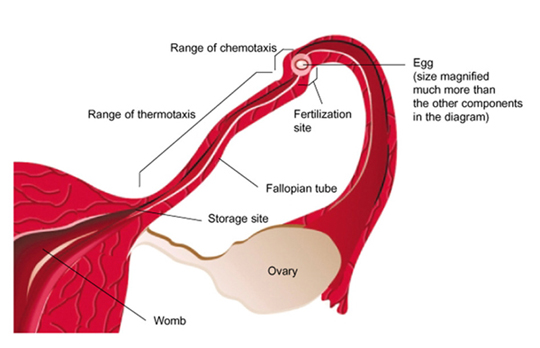Much like guided missiles that sense the heat of a plane's engine, sperm are guided to the fertilization site by temperature, reports a Weizmann Institute study published in the current issue of Nature Medicine.
The site where the egg lies is slightly warmer than the place where the sperm make a pause in their journey through the female genital tract. Sperm cells are apparently guided by this temperature difference in their navigation. Such a temperature-driven mechanism was previously known to exist in microorganisms and worms, but the Weizmann study for the first time has provided evidence for its existence in sperm cells.
According to team leader Prof. Michael Eisenbach of the Institute's Biological Chemistry Department, the study contributes to the understanding of fertilization in humans and other mammals. In the future, it may be possible to make use of temperature guidance to improve in vitro fertilization. The research was performed by Ph.D. student Anat Bahat, along with Anna Gakamsky, also a student in Eisenbach's team, Dr. Ilan Tur-Kaspa from the Barzilai Medical Center in Ashkelon and visiting scientist from Argentina Dr. Laura C. Giojalas.
After passing the womb, sperm cells enter the fallopian tubes. Once inside a tube, they attach themselves to the tube's wall and pause for 'storage,' during which they go through a maturation process that prepares them for penetrating the egg. A sperm that has completed this maturation process detaches itself from the wall and leaves the storage site. If ovulation had taken place in the preceding 24 hours, releasing an egg ready to be fertilized, the mature sperm would embark on a long, complicated journey through the tube to the site of potential fertilization.
How does the sperm steer a course through the fallopian tube? In the past, Prof. Eisenbach discovered that the egg 'calls upon' the mature sperm by releasing a chemical substance. (The first in a series of Eisenbach's studies on that topic was published in the Proceedings of the National Academy of Sciences, U.S.A. 1991;88:2840) However, the chemical signal can attract the sperm only across a short range: since the tube normally moves in a wavelike fashion, the chemical apparently cannot not spread effectively through the entire tube and therefore cannot dispatch a signal to the sperm over longer distances. Therefore, the chemical attraction, known as 'chemotaxis,' cannot account for the sperm's entire journey.
Some like it hot
What then allows the sperm cells to cover the distance between their storage site and the fertilization site within several minutes? That's precisely the question that Prof. Eisenbach and his team set out to answer. Since it was found that the sperm storage site is about 2 degrees C cooler than the site of fertilization, the scientists hypothesized that sperm may be attracted to the fertilization site by the temperature difference. The technical term for such attraction is 'thermotaxis.'
To test this theory, the scientists built a lab installation simulating the storage site, the fertilization site, and the tube in between. They tested the behavior of rabbit sperm in this system and found that the sperm were indeed sensitive to heat: they were attracted from the relatively cool area, with the temperature of 37 degrees C (98.6o F), to the relatively warm area, with the temperature of 39 degrees C (102.2 degrees F). When the scientists gradually reduced the difference in temperature, they found that even a half a degree difference was enough to attract the sperm. Moreover, the researchers found that only the mature sperm, the ones likely to penetrate the egg, acted as heat-guided missiles and were affected by the temperature difference.
Says Prof. Eisenbach: 'Apparently, the sperm are guided by temperature when they travel through most of the fallopian tube and navigate by tuning in to the egg's chemical call when they get close to the fertilization site.'
In further research conducted in collaboration with Prof. Haim Breitbart of Bar-Ilan University, the scientists obtained similar findings in human sperm cells.
Prof. Eisenbach is the incumbent of the Jack and Simon Djanogly Chair of Carbohydrate Biochemistry
The Weizmann Institute of Science in Rehovot, Israel, is one of the world's top-ranking multidisciplinary research institutions. Noted for its wide-ranging exploration of the natural and exact sciences, the Institute is home to 2,500 scientists, students, technicians and supporting staff. Institute research efforts include the search for new ways of fighting disease and hunger, examining leading questions in mathematics and computer science, probing the physics of matter and the universe, creating novel materials and developing new strategies for protecting the environment.
